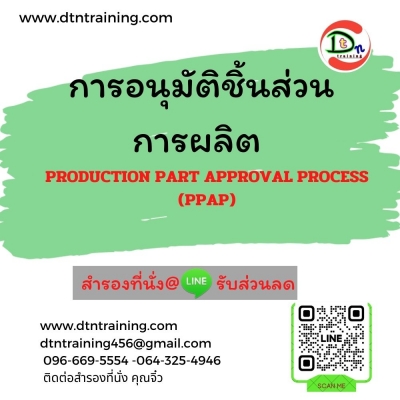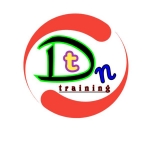การอนุมัติชิ้นส่วนการผลิต (PRODUCTION PART APPROVAL PROCESS) PPAP

หลักการและเหตุผล
เนื่องจากการแข่งขันที่สูงมากของอุตสาหกรรมยานยนต์ ทำให้บริษัทผู้ผลิตรถยนต์ทั่วโลกพยายามพัฒนาประสิทธิภาพการผลิตของตนเองและSuppliers โดยเน้นด้านคุณภาพสินค้าหรือบริการที่สูง การลดต้นทุน และการปรับปรุงอย่างต่อเนื่อง ทำให้องค์กรมาตรฐานสากลได้จัดทำมาตรฐานระบบบริหารคุณภาพISO/TS 16949สำหรับประยุกต์ใช้กับผู้ผลิตชิ้นส่วนยานยนต์ โดยมาตรฐานดังกล่าวได้กำหนดให้ต้องมีการวางแผนคุณภาพสำหรับการผลิตชิ้นส่วนล่วงหน้า (APQP)และจัดทำแผนควบคุมเพื่อให้มั่นใจว่าบริษัทจะสามารถผลิตชิ้นส่วนที่ตรงความต้องการของลูกค้าทั้งคุณภาพ ต้นทุน และการส่งมอบ และต้องมีกระบวนการอนุมัติชิ้นส่วนการผลิต (PPAP)เพื่อแสดงให้เห็นถึงความสามารถดำเนินการผลิตชิ้นส่วนตามข้อกำหนดของลูกค้า
วัตถุประสงค์ :
1.เพื่อให้ผู้เข้ารับการอบรมมีความรู้เกี่ยวกับกระบวนการวางแผนคุณภาพผลิตภัณฑ์ในแต่ละขั้นตอนและ กระบวนการอนุมัติชิ้นส่วนการผลิต
2.เพื่อให้ผู้เข้ารับการอบรมสามารถนาความรู้ที่ได้ไปใช้ในการดำเนินการในหน่วยงานของตน
หัวข้อการอบรม
•ความหมายและวัตถุประสงค์ของ PPAP
• PPAPคือ อะไร
•ทำไมต้องทำ PPAP
•การยื่น PPAP
•การผลิตสำหรับ PPAP
• PPAP Requirements (AIAG Manual)และOEM
•เมื่อใดที่ต้องแจ้งลูกค้า
•การเตรียมข้อมูลและเอกสารแต่ละเฟส
• PPAP Submission Prototype Stages (การทดลองการผลิตชิ้นงานต้นแบบ)
• PPAP Submission Pre-Lunch Stages (การทดลองการผลิตเสมือนจริง)
• PPAP Submission Mass Production Stages (ผลิตจริง)
•การเตรียมข้อมูลและเอกสารตามระดับการยื่นขออนุมัติ PPAP Levels of Submission
The PPAP submission requirements are normally divided into five classifications or levels, as follows:
• Level 1 - Part Submission Warrant (PSW) only submitted to the customer
• Level 2 - PSW with product samples and limited supporting data
• Level 3 - PSW with product samples and complete supporting data
• Level 4 - PSW and other requirements as defined by the customer
• Level 5 - PSW with product samples and complete supporting data available for review at the supplier's manufacturing location
•การจัดทำเอกสาร 18 ElementในPPAP
1. Design Documentation
2. Engineering Change Documentation
3. Customer Engineering Approval
4. Design Failure Mode and Effects Analysis
- Product malfunctions
- Reduced performance or product life
- Safety and Regulatory issues
5. Process Flow Diagram
6. Process Failure Mode and Effects Analysis
7. Control Plan
8. Measurement System Analysis Studies
9. Dimensional Results
10. Records of Material / Performance Tests
- Design Verification Plan and Report (DVP&R)
- Test report (ELV/RoHS)
- MSDS
- COA
- International Material Data System (IMDS)
- Other's Material requirement
11. Initial Process Studies
12. Qualified Laboratory Documentation
13. Appearance Approval Report
14. Sample Production Parts
15. Master Sample
16. Checking Aids
17. Customer Specific Requirements
18. Part Submission Warrant (PSW)
รูปแบบการเรียนรู้ : กิจกรรมกลุ่มWork shop case study +นำเสนอผลการวิเคราะห์และอภิปราย
กลุ่มเป้าหมาย : พนักงานระดับหัวหน้างานLine Leaderหรือพนักงานในไลน์การผลิตที่ได้รับมอบหมาย
สถานที่อบรม (VENUE)
สถานที่ @ โรงแรม แรมแบรนดท์ สุขุมวิท สุขุมวิท ซอย 18 ใกล้ BTS อโศก กรุงเทพฯ ** สถานที่อาจมีการเปลี่ยนแปลง
วันและเวลาอบรม (DATE AND TIME)
15 สิงหาคม 2567 09.00-16.00 น.

จัดโดย
ดีทีเอ็นเทรนนิ่ง
เบอร์ติดต่อ : 096-669-5554 ,064-325-4946
ค่าธรรมเนียม (FEE)
3900 (ไม่รวม ภาษีมูลค่าเพิ่ม 7%)


